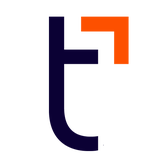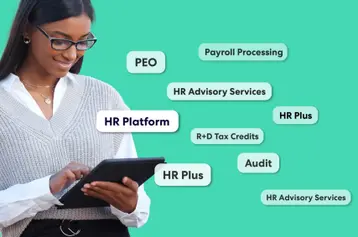A Guide to HRO Cost Savings and Financial Opportunities

Table of contents
- 1.Time Sink of Transactional HR: Adding Up Administrative Tasks
- 2.Saving Hours by Outsourcing Human Resources
- 3.Real-world results: Minimize costs and time
- 4.Long-Term Cost Containment: Leveraging Economies of Scale
- 5.Where the biggest savings could happen
- 6.Cost-effective group health plans
- 7.Personalizing customer service
- 8.Accessing an integrated technology solution
- 9.Going for integration
- 10.Risk avoidance: Share the liability, focus on your business
- 11.Sharing legal responsibility
- 12.Keeping track of records
- 13.Positioned for Tomorrow: Designing a Lean, Efficient HR Department
- 14.Launching employee productivity
- 15.Sustaining satisfaction
- 16.Recognizing the Power of Outsourcing
HR processes can be time-consuming and resource-intensive, but they are essential. Outsourcing HR can be a game-changer, especially for small and medium-sized businesses. When businesses outsource with a PEO, their annual median growth for double that of comparable non-PEO firms, with an added 16% increase in profitability.
Business owners who leverage HR outsourcing (HRO) find that they have more time to focus on their company’s core mission. They also report HRO cost savings on their essential HR functions, making it a key point of strategic planning.
Outsourcing HR provides businesses with significant benefits, including access to expert guidance and improved scalability as they grow.
By delegating routine administrative tasks, such as payroll, benefits administration, and record-keeping, companies can increase efficiency, reduce errors, and free up valuable time, enabling leadership to focus on core business growth rather than paperwork.Let's take an in-depth look at the financial benefits of contracting with a PEO based on industry best practices and TriNet’s experience as a leading PEO for small businesses since 1988.
Time Sink of Transactional HR: Adding Up Administrative Tasks
Transactional HR covers the daily, time-consuming activities that commonly face businesses, including payroll processing, benefits administration and updating employee records. For small business owners, these tasks can be a significant time drain.
The transactional nature of HR means these tasks are essential but add little value to your core business mission or bottom line. Every hour spent on paperwork, compliance, or routine administration is an hour not spent on growth, customer service, or innovation.
Through HR outsourcing, these administrative HR tasks can be delegated. Professional employer organizations (PEOs) are designed to absorb these time-consuming activities, allowing you to focus on your business without being overwhelmed by paperwork.
The opportunity cost is real: The more time leadership and staff are tied to routine administration, the less agility a business has in responding to opportunities and challenges.
Saving Hours by Outsourcing Human Resources
Curious how much your business can save both in dollars and hours by outsourcing HR? Try out TriNet's ROI calculator to see potential cost savings tailored to your company’s needs.
Businesses working with a professional employer organization (PEO) like TriNet often report saving more than $17,750 per year for an average 10-employee company, thanks to efficiencies in administration, compliance, and employee benefits management.
Real-world results: Minimize costs and time
NY State Solar is a great example of a fast-growing business cutting costs and saving time by consolidating HR tasks through TriNet. Instead of expanding its internal HR team, NY State Solar relies on TriNet’s technology and expertise to manage complex HR needs.
This approach allowed them to “keep a relatively lean HR staff internally and lean heavily on TriNet’s technology and capabilities to minimize our cost,” especially while scaling and managing a multi-state workforce.
Similarly, iMerit turned to TriNet for a cost-effective, transparent solution that could support a distributed team. The switch eliminated the need for multiple vendors while giving them access to everything under one integrated platform.
They cite TriNet’s “cost-effective price” and clear, consolidated service as key reasons for continued growth and simplified HR operation
The time you save by outsourcing HR can vary greatly, depending on how many providers you use and how much of the administration you choose to keep in-house.
For example, if you choose the multi-provider approach, or use a different vendor for each of your administrative tasks. In that case, you’ll need to factor in the time required for soliciting, reviewing, and comparing different vendor proposals as well as vendor management.
Not to mention the ongoing overhead cost of managing a multi-provider network with the associated IT integrations, you’ll find that time saved by outsourcing may fall far short of its potential target.
To realize greater efficiencies, a growing number of companies are consolidating HR outsourcing functions into an integrated solution offered by a single provider. Otherwise known as a PEO.
These companies have found that their PEOs are professionally and technologically equipped to handle the full range of HR services, provide a single point of contact, and ensure full customer service. All these efficiencies result in true time savings for your company.
Long-Term Cost Containment: Leveraging Economies of Scale
Keeping long-term HR costs low is achievable when businesses leverage economies of scale through outsourcing. The basic principle is simple: the more people who need the same HR service, the lower the average cost per person.
Where the biggest savings could happen
The most significant HR areas for long-term cost management tend to come from benefits administration and technology support. By joining larger HR networks or utilizing professional employer organizations (PEOs), companies can:
- A PEO can pool together the employees of all its clients to provide access to benefits that typically are available only to big companies. The businesses can offer higher-quality plans at lower rates.
- Likewise, PEOs can purchase, upgrade and maintain sophisticated HR technologies for every area of HR. Businesses gain access to advanced tools for payroll management, benefits, performance metrics, and risk management that they would be hard pressed to obtain on their own.
- Free up leadership to focus on business growth rather than administrative distractions.
Cost-effective group health plans
TriNet constantly researches the differences between our group-sponsored plans, other available group plans, and the individual plans offered by carriers.
Individual plans appear to provide a mildly decreased level of coverage for a greatly reduced price. We have found, however, that such plans could damage our customers’ ability to protect the health and welfare of their employees.
"Ensuring that our team doesn't just have benefits, but good benefits, is important," says CEO and co-founder of Dagne Dover, Deepa Gandhi. That's why they started working with TriNet for an all-inclusive HR solution in 2014 and never looked back.
"We needed a solution that would make providing access to benefits easy for us. Through some recommendations and evaluation of a couple of different companies, we came to TriNet and haven't looked back since."
Personalizing customer service
Most employees will rest easier knowing they have access to customer service representatives who can troubleshoot benefits issues and get answers to their questions immediately.
With a PEO, you won’t need in-house, on-call HR specialists to field emergency calls, enrollment issues with new hires, or routine administration snags. PEO staff provide process optimization because their entire focus is on HR.
TriNet’s own call center offers toll-free access to subject matter experts, plus an HR Consultant Hot Line for your managers who need instant assistance with HR-related matters.
About 80% of employee issues are resolved by TriNet within the first call. The remaining are escalated and resolved within an average response time of two hours. For non-urgent issues, employees can contact TriNet’s Solution Center by email or online “instant chats” for comprehensive answers to all their questions.
A company's Account Management team provides the same level of day-to-day support to its managers as TriNet’s customer service representatives offer to its employees. The team is available to:
- Walk you through our online Customer Set Up process
- Field special requests such as payroll needs or complex workforce management issues.
- Make sure you and your managers are comfortable and satisfied with every aspect of our HR services.
Accessing an integrated technology solution
Employees and employers alike are accustomed to instant access to everything from delivery to streaming at the touch of a button. Benefits and time tracking are no exception. Employees, especially top talent, expect app access to manage their benefits.
But the cost of implementing and maintaining a state-of-the-art human resources information system (HRIS) is simply out of reach for the average small and medium-sized business. With a PEO, this is no longer a problem.
PEOs license and maintain their own enterprise-level platforms to handle all their customers’ HR administrative processes.
Users enjoy access to a portal that is easy to use and highly customizable. Managers and employees can access and administer HR transactions from laptops, PCs and mobile phones. Your staff can access their HR information online whenever it's convenient. Employees can:
- Change options during open enrollment
- Set up direct deposit
- Update personal information
- Change withholding on their W-2s
- Perform manager-level transactions such as hiring and submitting payroll
This easy access allows your personnel to avoid losing productivity in the work day.
A wide range of additional information can be posted online to help your employees make the right choices, including handbooks and FAQs on benefits offerings, and online chat and customer service. Managers will also find that PEO online services streamline access to company data and reports.
The prospect of transferring your company’s personnel data off site may give you pause. Yet, using a PEO will provide you with more control over processes and improve the quality of information. With a dedicated, highly trained IT staff, a PEO’s HRIS system suffers fewer data errors and offers greater timeliness of reports, more consistency in delivery, and tighter security.
Leveraging the power of online HR doesn’t mean compromising security. TriNet, for example, protects its Internet-based services with SSL encryption, individual passwords, leading-edge firewalls, and intrusion detection systems.
Going for integration
TriNet’s HR technology platform also integrates with popular business software such as Oracle, Xero, Intuit Quickbooks and Sage Intacct to help you boost productivity. In fact, the platform integrates with software for many purposes, including:
- Applicant tracking
- Employee engagement
- Benefits, retirement savings, and wellness
- Identity providers
- Productivity
TriNet's state-of-the-art HRIS offers maximum efficiency for processing transactional HR, mainly because it is a single platform.
The system integrates the latest personal data into all HR services applicable to a particular individual. Seamless data integration is what makes payroll and benefits processes faster, cheaper, more accurate, and secure.
Integration is what drives your ROI.
Risk avoidance: Share the liability, focus on your business
In this litigious climate there is little room for administrative error. If a company incorrectly handles any of its numerous HR functions, it is at risk for a lawsuit or claim.
If filing deadlines are missed, the resulting fines and penalties can erode the bottom line of any small or medium business.
As the complexities of compliance multiply each year, companies are forced to spend more time on avoiding risk and less time on revenue- and profit-generating activities.
Sharing legal responsibility
When you contract with a PEO, you can focus on a marketing campaign or signing on a new client knowing that you have help with all the mounting transactional HR tasks and the risks associated with them.
You can build a distributed workforce—tapping into talent anywhere in the country—without worrying about the payroll withholding and workers’ compensation requirements of other states.
The employer shares certain liabilities and risks with the PEO, as the PEO assumes responsibility for employment-related compliance and risks.
How does this work? Some states regard PEOs as co-employers and the IRS recognizes PEOs as employers because they assume certain legal rights and duties for their customers’ employees, such as paying wages and related withholdings taxes.
This means the PEO is liable for paying these taxes whether or not the PEO is paid by the client. The PEO must also provide the employees with workers compensation, state and federal unemployment, and statutory disability coverage.
Moreover, when the PEO administers any employee benefits programs related to retirement plans, health plans, life and disability insurance, or credit unions, it leads the way to benefit plan compliance with applicable state and federal laws. This also includes the plan’s testing, filing, and other obligations.
In most circumstances, the PEO also contractually agrees to assist with compliance with many regulations, including the:
- Fair Labor Standards Act
- Family Medical & Leave Act
- Health Insurance Portability & Accountability Act (HIPAA)
- COBRA
PEOs are legally obligated to stay on top of all employment laws and regulations so they can provide their co-employees with compliant worksites. This is no small task given the explosion of employment laws in the last 25 years.
According to the U.S. Small Business Administration, the number of employment-related laws and regulations grew by 60% between 1980 and 2000 alone. But the PEO provides a back office team that boosts your ability to identify and resolve risk-related issues—before they consume your business.
Keeping track of records
Since 2000, a new legal emphasis on records’ retention has compelled businesses to invest more heavily in document management technology and practices that prepare them at all times to produce claim forms, W-2s, reimbursement invoices, and a wide range of other documents, all at a moment’s notice.
Whether the information is 5 weeks old or 5 years old, PEOs shoulder all the responsibility for storage and retrieval of HR-related data. Records are typically backed up to off-site devices to insure against data loss from on-site technical failure or disaster.
In the event of an audit, inquiry, or claims dispute, your PEO is always equipped to rapidly locate and produce the record in question. In short, they assume many HR responsibilities, which include recordkeeping and documentation as well as explanation.
Because shouldering the burden of proof is a key component of their services, PEO staff have the regulatory expertise and technological tools to handle the growing volumes of a company’s HR records as the business matures.
Positioned for Tomorrow: Designing a Lean, Efficient HR Department
The time and cost savings from outsourcing HR are hard to pass up. Yet these benefits are merely part of a much more significant return on investment from your company’s relationship with a PEO. Once you’re relieved of the HR administrative burden, you can refocus your attention on sustainable, revenue-generating activities.
A key component of this strategy is revving up lean and efficient HR processes to develop your most valuable asset—your employees.
Launching employee productivity
For small businesses, especially startups, it’s crucial to attract the type of highly skilled and motivated professionals who can hit the ground running. In these types of businesses, there’s the undeniable energy that results when strong entrepreneurial vision, market forces, and investment dollars come together.
In the excitement, it’s all too easy to miss the signs of chaos and dissatisfaction growing daily in the work environment and threatening to undermine worker productivity. PEOs take care of the HR administration to leave you and your employees to focus on what you do best.
With a PEO, you have the time to deliver the full range of support and direction your workforce requires to sustain high performance. It’s essential to get your business on solid footing with all HR administrative processes up and running painlessly and in record time.
Regardless of how fast a business grows, its new hires should always expect to receive their first paycheck and their health coverage to kick in exactly on schedule.
Sustaining satisfaction
Recruiting, training, fine-tuning policies and procedures, and creating a company culture are the building blocks of workforce development.
Thanks to outsourced HR administration, your HR managers can devote more quality time to all of the above and turn to their PEO for additional expertise. PEOs like TriNet are staffed with HR professionals who can be called upon to perform a wide range of HR services, from training on team building and stress reduction to answering employee questions on benefits and screening recruits.
The value of TriNet’s services is not merely that they are available, but that they are truly flexible and can suit your particular budget and business requirements. At TriNet, one size does not fit all. Wireless device leader, Socket Communications, has frequently tapped into TriNet’s extended services menu since becoming a customer more than 15 years ago.
TriNet “gives us guidance on everything from 401(k) providers to employee ergonomics to workers' compensation,” says Socket CFO David Dunlap. “As Socket grows we can add additional layers of on-site support as needed. For us, the ability to gain increments of support personnel is invaluable.”
Recognizing the Power of Outsourcing
Regardless of how extensively you use a PEO, its representatives—whether they are customer account managers, customer service representatives, trainers, or recruiters—will work closely with your workforce over the long-term.
That’s why a compatible corporate culture is one of the top criteria companies look for when choosing a PEO. And that’s why companies with professional and technical workforces are a natural fit for TriNet.
With its own lean and efficient professional staff, TriNet doesn’t have to work at communicating with a customer. It already speaks the same language and shares the same commitment to high-level performance and sustaining competitive advantage.
To learn more about the value of a PEO, download our free eGuide: Going Beyond Payroll: Saving HR Administration Costs
This article is for informational purposes only, is not legal, tax or accounting advice, and is not an offer to sell, buy or procure insurance. It may contain links to third-party sites or information for reference only. Inclusion does not imply TriNet’s endorsement of or responsibility for third-party content.

TriNet Team
Table of contents
- 1.Time Sink of Transactional HR: Adding Up Administrative Tasks
- 2.Saving Hours by Outsourcing Human Resources
- 3.Real-world results: Minimize costs and time
- 4.Long-Term Cost Containment: Leveraging Economies of Scale
- 5.Where the biggest savings could happen
- 6.Cost-effective group health plans
- 7.Personalizing customer service
- 8.Accessing an integrated technology solution
- 9.Going for integration
- 10.Risk avoidance: Share the liability, focus on your business
- 11.Sharing legal responsibility
- 12.Keeping track of records
- 13.Positioned for Tomorrow: Designing a Lean, Efficient HR Department
- 14.Launching employee productivity
- 15.Sustaining satisfaction
- 16.Recognizing the Power of Outsourcing






